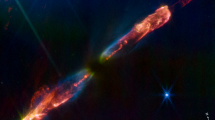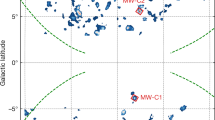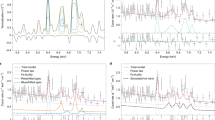Abstract
The environs of interstellar space in which star formation takes place involve high-velocity gas flows. Channelled by embryonic dust toroids, these gas flows culminate in energy-losing shock processes at the interface with the ambient interstellar cloud. The excitation of molecular hydrogen transitions in this gas provides one means of observing these shocked regions and their relation to the well-known indicators of star formation such as the Herbig Haro objects and T Tauri stars. In an attempt to understand the relationship of the recently discovered complex of Herbig Haro objects in Orion1 to the IR sources in this region, we have carried out a survey of the molecular hydrogen S(1) line distribution. These observations have led to the discovery of a previously unsuspected structure of finger-like filaments of H2 emission extending radially outwards from a common centre at IRC9.
This is a preview of subscription content, access via your institution
Access options
Subscribe to this journal
Receive 51 print issues and online access
$199.00 per year
only $3.90 per issue
Buy this article
- Purchase on Springer Link
- Instant access to full article PDF
Prices may be subject to local taxes which are calculated during checkout
Similar content being viewed by others
References
Taylor, K. & Axon, D. Mon. Not. R. astr. Soc. 207, 241–261 (1984).
Allen, D. A. & Cragg, T. A. Mon. Not. R. astr. Soc. 203, 777–783 (1983).
Wright, M. C. H., Plambeck, R. L., Vogel, S. N., Ho, P. T. P. & Welch, W. J. Astrophys. J. Lett. 267, L41–L45 (1983).
Nadeau, D., Geballe, T. R. & Neugebauer, G. Astrophys. J. 253, 154–166 (1982).
Scoville, N. Z., Hall, D. N. B., Kleinmann, S. G. & Ridgway, S. T. Astrophys. J. 253, 136–148 (1982).
Beckwith, S., Persson, S. E., Neugebauer, G. & Becklin, E. E. Astrophys. J. 223, 464–460 (1978).
Downes, D., Genzel, R., Becklin, E. E. & Wynn-Williams, C. G. Astrophys. J. 244, 869–883 (1981).
Norman, C. & Silk, J. Astrophys. J. 228, 197–205 (1979).
Rodriguez, L. F., Moran, J. J., Ho, P. T. P. & Gottlieb, E. W. Astrophys. J. 235, 845–865 (1980).
Tenario-Tagle, G. & Rozyczka, M. Rev. Mex. Astr. Astr. 7, 124–125 (1983).
Beck, S. C. Astrophys. J. (in the press).
Author information
Authors and Affiliations
Rights and permissions
About this article
Cite this article
Taylor, K., Storey, J., Sandell, G. et al. Molecular hydrogen jets from the Orion nebula. Nature 311, 236–237 (1984). https://doi.org/10.1038/311236a0
Received:
Accepted:
Issue Date:
DOI: https://doi.org/10.1038/311236a0
This article is cited by
-
Heated gaseous streamers and star formation in the Orion molecular cloud
Nature (1996)
-
Bullets or fragmenting shells?
Nature (1995)
-
Molecular shocks in star forming regions
Astrophysics and Space Science (1995)
-
Fragmentation and heating of streamers in orion
Astrophysics and Space Science (1994)
-
Explosive ejection of matter associated with star formation in the Orion nebula
Nature (1993)
Comments
By submitting a comment you agree to abide by our Terms and Community Guidelines. If you find something abusive or that does not comply with our terms or guidelines please flag it as inappropriate.



